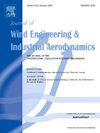Streamline curvature effects generated by tornado-like flows on the aerodynamics of a low-rise structure
Abstract
This paper examines the streamline curvature effects on the aerodynamic pressure patterns induced by tornado-like flows on a low-rise structure. The analysis derives from the detailed scrutiny of a wind tunnel test campaign carried out at the WindEEE Dome tornado simulator. The simulated tornado-like flows were characterized by a swirl ratio such that the cores were characterized by multiple vortices. The tornado-like vortex was slowly translated across the chamber of the simulator. Surface pressure measurements were acquired on both the building model surface and on a circular ground plate around it, and synchronized with velocity measurements gathered from four Cobra probes installed in the proximity of the corners of the structure. These Cobra probes allowed the definition of the tornadic streamlines. Multiple nominally identical repeats were carried out to gather a robust estimation of conditionally-averaged pressure and velocity measurements based on the position of the tornado-like vortex. When comparing different cases characterized by similar conditions of upstream wind direction, the mean aerodynamic pressure patterns were revealed to be sensitive to the streamline curvature. Moreover, these are distinct than those generated from straight-line ABL winds, consistently calibrated upon the measurements from the Cobra probes in the upstream proximity of the building.

 求助内容:
求助内容: 应助结果提醒方式:
应助结果提醒方式:


